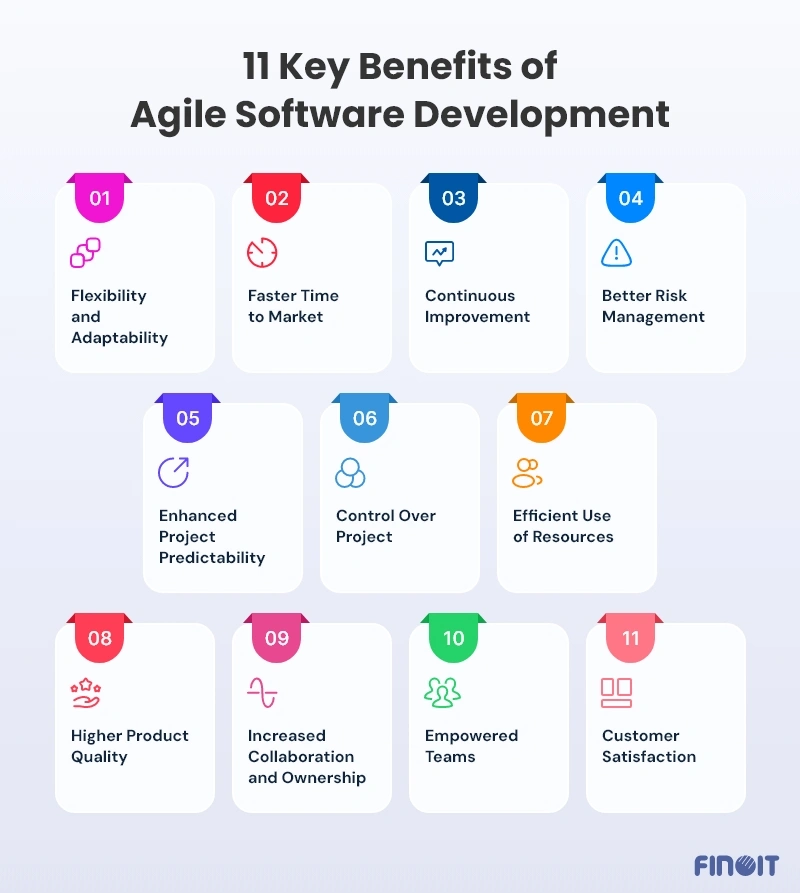11 Key Benefits of Agile Software Development You Must Know

Agile methodologies have become the gold standard in software development due to their lightweight processes relying on iterative cycles; these methodologies stand in stark contrast to traditional plan-driven approaches.
There is so much to discuss about Agile as it brings improvements in every corner. Since its evolution in the early 20th century with the Agile manifesto, it has allowed and helped numerous enterprises optimally build quality software products.
One of the most significant advantages of Agile methodology is it prevents cost overrun. Traditional approaches often suffer from rigid plans that fail to account for the inevitable changes and uncertainties in software development. On the contrary in Agile, change management is much more swift, which eliminates the risk of costly delays and budget blowouts.
To put in the words of Elisabeth Hendrickson, Agile enabler, “Agile teams produce a continuous stream of value, at a sustainable pace, while adapting to the changing needs of the business.” One of the simplest yet most powerful explanations, these words define the vitality and viability of agile in modern software development projects.
11 benefits of Using Agile Methods in Software Development
- Flexibility and Adaptability
- Faster Time to Market
- Continuous Improvement
- Better Risk Management
- Enhanced Project Predictability
- Control Over Project
- Efficient Use of Resources
- Higher Product Quality
- Increased Collaboration and Ownership
- Empowered Teams
- Customer Satisfaction
Flexibility and Adaptability
Agile stands out for its exceptional adaptability, and teams can pivot efficiently as new customer requirements or market trends emerge. In an environment, where rigidity can lead to missed opportunities or project misalignment, this ability to adapt is crucial which Agile brings, something that 83% of businesses have experienced.
Feedbacks and iterative cycles are the cornerstone of this remarkable capability of Agile frameworks due to which the project continues without derailing the overall timeline or incurring substantial costs. This dynamic nature ensures that teams can address unforeseen challenges promptly, maintaining the project’s relevance and value.
The iterative approach necessarily means supporting continuous reassessment and reprioritization of tasks, where the most critical aspects are always addressed first. Flexibility extends to accommodating changes even in advanced stages of development, unlike traditional methodologies that might require significant rework. So, in Agile, teams have scope to experiment with innovative solutions and quickly integrate successful ideas into the project.
Faster Time to Market
How fast software products penetrate the market makes a huge difference, as Michael Hugos summarizes in these words, “Agility means that you are faster than your competition”. The first one to enter the market achieves around 50% to 70% share and the rest gets divided amongst the remaining entrants. Using agile, you can secure this advantage.
Prioritizing rapid delivery, Agile significantly reduces the time it takes to bring a product to market, accelerating the software delivery by 64%. As we discussed it breaks down the project into smaller, manageable iterations, and delivers key features incrementally. Agile thus fetches numerous benefits for startups looking for quick success.
The approach allows for the early release of a minimum viable product (MVP) that can be tested and refined based on user feedback. Enterprises resting on Agile models like Scrum thus respond more swiftly to market demands and gain a competitive edge by being first to market with new innovations. The ability to remain first in the race is one of the most significant benefits of agile methodology.
Incremental delivery not only accelerates the development process but also allows for quicker user validation. Early and regular releases enable businesses to maintain project momentum, gather insights and make informed adjustments so as to not just adhere to speed requirements but simultaneously meet the quality criteria.
Continuous Improvement
“Continuous attention to technical excellence and good design enhances agility,” as Agile manifesto states.
The principle of continuous improvement is central to all Agile software development methodologies, and so it has gained popularity, aiding 98% of businesses that adopted and employed it.
As said, the idea of adding incremental value makes it possible. Each iteration provides an opportunity for teams to assess and enhance their work. The cycle of regular evaluations and refinements helps to gradually elevate the product’s quality and effectiveness.
Teams conduct retrospectives at the end of each iteration to reflect on what is fine and what needs improvement, based on which they come up with action plans to fill the gaps. These insights are then applied to subsequent iterations and achieve what has been missed.
The product follows a steady progression through the lifecycle, with the movement not halting at any stage. Rather than waiting for a final release to identify and address flaws, teams make continuous adjustments. While reducing the chances of risk, this approach helps maintain a high standard of quality.
Additionally, Agile’s focus on continuous improvement extends beyond the product itself as it encompasses team dynamics and processes. When teams conduct reviews they can reflect on and identify inefficiencies and obstacles and build more streamlined workflows.
Better Risk Management
Without an iota of doubt, Agile processes excel in risk management. In fact, the philosophy is steered by the idea of risk minimization and risk mitigation. What makes this possible is the feature of breaking down projects into smaller, more manageable units.
Each iteration works as an individual cycle involving planning, execution, and review, where teams identify and address risks early in the process, which straightaway reduces the likelihood of issues arising later in the project.
Risk checklists, assumption analysis, document reviews and tools like risk boards and burn-down charts are critical to assessing and monitoring risks. Applying these methodologies help in controlling risks in projects.
The ongoing assessment helps in identifying potential risks before they escalate, allowing for timely mitigation strategies. Team members are encouraged to raise concerns and discuss potential risks openly and issues can be addressed collectively.
Enhanced Project Predictability
The consistency of cycles establishes a predictable rhythm, making it easier to plan and manage resources effectively. Each iteration sets clear expectations and timelines. Reducing uncertainty, reviews and retrospective enable more accurate forecasting of progress and outcomes of the software project.
Structured planning in Agile methodologies involves setting specific goals and deliverables for each iteration, which provides a clear roadmap for the team. The granular approach to planning helps in identifying potential bottlenecks and allocating resources more efficiently. Tracking the following metrics helps you measure the predictability of agile methodologies:
- Velocity: Measures the amount of work a team can complete during a sprint, helping to predict future performance.
- Sprint Burndown: Tracks the remaining work in a sprint to determine if the team is on track to complete its tasks.
- Release Burndown: Similar to sprint burndown but over the course of multiple sprints, showing progress towards a release.
- Cycle Time: The time it takes for a task to move from the start to the end of the workflow, indicating the efficiency of the agile development process.
- Lead Time: Measures the total time from when a task is created to when it is completed, reflecting the overall process efficiency.
- Cumulative Flow Diagram (CFD): Visualizes work in progress across different stages, helping to identify bottlenecks and understand workflow stability.
- Escaped Defects: Counts defects found after release, indicating the quality of the delivered software and the effectiveness of the testing process.
- Team Happiness: Often measured through surveys, this metric can indicate team morale and its impact on productivity and predictability.
- Throughput: The number of work items completed in a given period, providing insights into the team’s capacity and consistency.
- Work Item Age: Tracks the age of active work items to identify potential delays and areas needing attention.
Control Over Project
With its frequent cycles of planning, execution, and review, Agile offers software development teams regular checkpoints to assess their progress. Each iteration begins with a sprint planning session where goals are clearly defined, and tasks are assigned, giving the team a focused agenda for a short, manageable period.
Daily stand-up meetings, sprint reviews, and retrospectives are key to keeping control on projects. These regular interactions provide a platform to discuss progress, address roadblocks, and assist project managers and project leads in making right decisions.
Agile teams have to leverage a variety of tools like burndown charts, Kanban boards, and velocity tracking to offer visual insights into the team’s performance and the project’s status. Using these tools makes the process of identifying trends, predicting outcomes, and adjusting plans as necessary easy. From another angle, stakeholders are consistently engaged and informed about the project’s development which keeps a check on all ongoing activities.
Efficient Use of Resources
Agile allows for continuous reassessment of resource needs and allocates the right people to the right tasks at the right time. Preventing over-allocation or under-utilization of resources, the approach promotes a more balanced and efficient workflow, maximizes productivity and avoids the burnout prevalent in traditional models.
The cross-functional nature of teams is another big advantage as it contributes to efficient resource use by bringing together diverse skills and expertise. Ongoing dialogue ensures that resources are allocated effectively and that any potential bottlenecks are addressed in a timely manner.
Timeboxing, backlog grooming, and use of burndown charts pave the way for resource optimization in Agile. Here is how they contribute:
- Backlog grooming: Involves regular review and prioritization of tasks, making sure that the team is always working on the most valuable items and so resources can be adjusted as needed.
- Timeboxing: Sets fixed periods for tasks, making work progresses steadily without dragging on, and helps allocate resources based on current capacity and skills.
- Burndown charts: Visually tracks the progress of work against time, and allocate resources as necessary.
Higher Product Quality
Each iteration in Agile involves continuous testing and feedback which massively reduces the likelihood of defects. Testing in every phase of development helps maintain a high standard of quality throughout the project’s lifecycle and achieve the required software quality characteristics. With Agile, you can thus improve your product quality by up to 250% and this is remarkable.
Active involvement of all stakeholders, including developers and end-users in reviewing and testing is key here. High-quality software applications produced is the result of these practices that Agile encourages:
- Test-Driven Development (TDD): Developers write tests before writing the actual code so that the code meets the required functionality and reduces the chances of bugs.
- Pair Programming: Two developers work together on the same code. One writes the code while the other reviews it in real-time.
- Refactoring: Regularly improving the codebase without changing its external behavior ensures that the code remains clean, efficient, and easy to maintain.
- Code Reviews: Systematic peer reviews of code before merging into the main branch help catch errors, ensure adherence to coding standards, and improve code quality through collective knowledge sharing.
Increased Collaboration and Ownership
Streamlined collaboration for smooth project progress is an important element of Agile project management. There is a common goal and cross-functional teams work together bringing diverse skills and perspectives to the table and management and development practices are intertwined to achieve it. Everyone is on the same page and there are no misunderstandings, which is one important reason why team cohesion and productivity are strong in Agile.
Most importantly, responsibilities are shared, and roles are often fluid, and team members have to contribute in various capacities. Team members are encouraged to take initiative and the environment is transparent and inclusive to accommodate suggestions. Joint accountability motivates team members to support each other in overcoming challenges and deliver high-quality working software.
The collaborative nature of Agile works as a facilitator for innovation, as bringing together diverse perspectives and expertise effectively tackles problems. By breaking down silos and encouraging cross-functional collaboration, Agile teams approach challenges more creatively and effectively.
Empowered Teams
In his book, The Art of Doing Twice the Work in Half the Time, Jeff Sutherland mentions how Scrum improves team productivity by a whopping 300% to 400%.
Agile empowers teams as it promotes decision-making at the operational level, and those directly involved in the work can make informed choices and self-organize activities. The decision-making process is decentralized that creates an environment where individuals feel valued. Innovation in Agile comes from this trust which drives the ultimate success.
While assuring product quality, Agile provides opportunities for team members to grow and develop their skills. Regular retrospectives and feedback sessions help identify areas for improvement and celebrate successes. Empowered teams are better equipped to respond to challenges and seize opportunities, because they have the autonomy and confidence to take action.
Customer Satisfaction
Agile integrates the customer into the development process by seeking feedback and using those for making updates. It imbibes this principle of Agile manifesto, “Our highest priority is to satisfy the customer through early and continuous delivery of valuable software.”
Customers provide feedback during frequent review sessions, and provide opportunity for the development team to make timely adjustments. As a result, a transparent relationship is built between customers and the development team. Customers feel their input is valued, as the final product genuinely meets their requirements.
As highlighted in the research, How Agile Practices Impact Customer Responsiveness and Development Success, customer satisfaction in Agile comes from key practices that it encourages. These include pair programming, collective code ownership, and daily-standups. These practices lead to team response effectiveness and team response efficiency that contribute to customer satisfaction.
Involving customers in the process right from the inception offers an advantage for the detection and correction of potential misalignments before they escalate and become significant issues.
Regular feedback loops mean that the product evolves based on actual user experience rather than assumptions, which means it’s relevant. The practice of delivering incremental updates builds a product that cent percent aligns with customers expectations.
Takeaway: Treat Agile more than a Methodology
Never look at Agile as a particular project management methodology, but as a philosophy that encourages continuous improvement and flexibility in driving projects. Take it as an opportunity to secure not just one but many advantages. You should develop a culture where it gets automatically assimilated in all projects you execute.
The complexity of applying Agile comes from critical questions revolving around the choice of agile methodology and then implementation of the chosen agile approach. Especially, the choice of methodology for startups is tricky as they need some hand holding.
This may sound a complex task, but not if you seek assistance of a professional software development specialist honed in agile principles.


